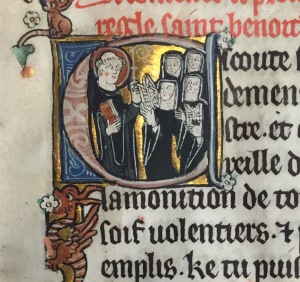The wonderful historiated initial below comes from the opening of a copy of the La regle saint Benoit, a French translation of the Rule of Saint Benedict.
The illustration shows Saint Benedict addressing four attentive nuns.
The artist incorporates suggestive details that give the scene a
liveliness that is surprising for so small a picture. scene:: The nun closest to
Benedict points to a passage, as if asking for clarification. Benedict
holds his book closed, appearing to keep his place with his index finger
as he pauses to answer a question.

Decorated initials are among the most striking features of
manuscripts, but they were not widely attested until the Middle Ages.
Books were rarely decorated in the ancient world because, even though
literacy rates were higher, oratory remained the principal means of
delivery while the physical books and scrolls were relegated to
supporting roles.
During the Middle Ages, with the influence of Christianity, the book
became important both symbolically and practically as an instrument of
textual transmission. Decorated initials helped to reveal the structure
of a text by emphasizing the beginnings of works, sections and verses.
Historiated initials such as this one tended to be reserved for major
divisions, while smaller initials might break a text into sections. A
memorably decorated initial would help a reader locate its associated
text. This is especially so when it reflected the text’s meaning, as in
this case, where the initial introduces the sentence, Escoute fille les coma[n]demens de ton maître
[Listen, daughters, to the commandments of your teacher]. It may seem
odd that the initial, so appealing to the eye, introduces the injunction
to “listen.” It reflects a cultural milieu in which the reception of
texts was both auditory and visual.
This particular copy of the Rule I could find was produced in northeastern France toward the end of the
thirteenth century. It also contains other
devotional works, including Li livres des tribulations, Chanson d’amors de pure povreteit,
and three short treatises. The French has feminine inflections,
suggesting that the book was made for a female readership. An
inscription pasted into the book by Claude de Grilly, a nun at the Abbey of Sainte-Glossinde, suggests the book may have been made for that
convent. JC
A couple of sources beeeelow... (sorry, is late while typing this after a hard day at job hehe) ::
- Benedict, Saint, Abbot of Monte Cassino. La regle saint Benoit. ([Lorraine, approximately 1275-1300]). Pre-1650 MS 0098. University of Illinois
- Link provided to an Ebay seller (digital-scriptorium) that has auctions on ebay for a digitized copy of an 8th Century Rule of San Benedict of Nursia, probably this was one of the first editions commissioned.